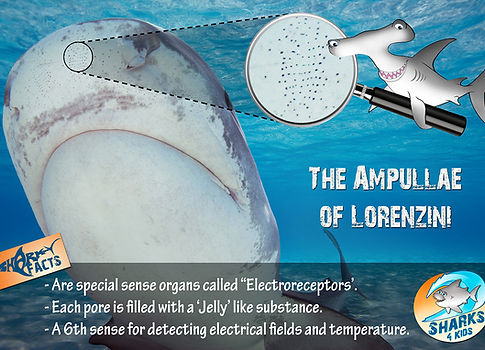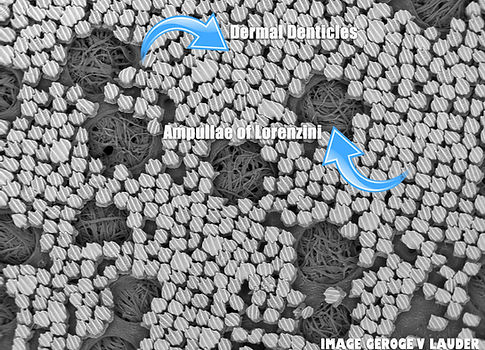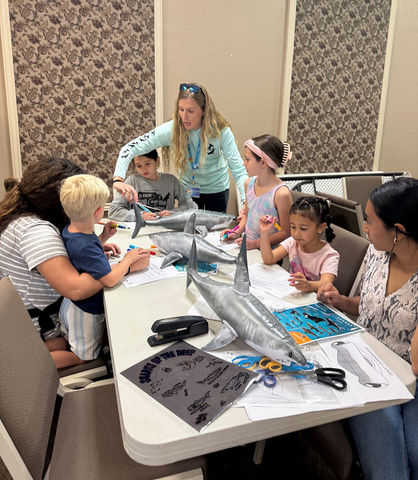
SMELL (OLFACTORY)
Sharks have highly developed olfactory senses. Smell is probably their most important sense. Sharks are often referred to as ‘’swimming noses’’. They are able to smell one millilitre of blood in one million millilitres of water. The olfactory senses are found between the bottom and top nasal openings. The shark pulls water into the nasal sacs and across folds of skin known as olfactory lamellae (plates) studded with chemoreceptors. These receptors increase sensitivity to surrounding smells, making their prey tracking ability legendary. Sharks do not rely on their noses for breathing, but they do rely on their olfactory senses to help them navigate over long distances as a result of their ability to sense chemical gradients in the water.


SIGHT (VISUAL)
Visual capabilities vary among the different shark species. Some have very poor sight, some have light sensitive eyes, and some have a wide field of vision. A shark’s eye consists of a cornea, iris, retina, and rods and cones allowing them to see in colour and at different levels of light. They also have a tapetum lucidum, which is a layer of tissue with a mirror effect that enhances the eye’s sensitivity to light. Located on the sides of the head, a shark’s eyes allow for almost 360 degrees of vision. Some species of shark have a protective eyelid called nictitating membrane which extends from the bottom to the top of the eye and protects it when sharks are feeding. It is thought that sharks use their visual sense (suitable for ambushing in low lighting conditions such as sunrise or sunset) just before they approach their prey.


SOUND (AUDITORY)
Water is a much more effective conductor than air. Sound travels much further and faster in the ocean, which allows sharks to detect their prey from around 800 meters (2,625 ft - 1/2 a mile) away, or two football fields. Sharks don’t have external ears, but they have an inner ear which is involved in sound perception and balance, just like our inner ear. The three compartments within the inner ear are called the sacculus, the lagena, and the utriculus. These are covered in tiny hairs that allow for the directional detection of low-frequency sounds often caused by wounded fish.

TASTE (GUSTATION)
Sharks do not have tongues, but some sharks have taste bud receptors. However there is no evidence that sharks can distinguish between bitter, sweet, salty, and sour. It is believed that sharks use their taste buds simply to determine what is and what is not food.

ELECTRORECEPTION
Every animal living in the marine realm creates electric signals. Sharks have sensors that can pick up electric signals using highly sophisticated sensory organs called Ampullae of Lorenzini. These sensory organs allow them to hunt effectively at night and detect weak, low-frequency electrical fields given off by prey that might be hiding in the sand (like stingrays). The Ampullae of Lorenzini are a network of jelly-filled pores with sensory cells and a tube-like canal at the surface of the skin. Oceanic currents moving in Earth's magnetic field produce electric fields. The electroreceptors allow sharks to orient the magnetic fields and navigate across the ocean.



LATERAL LINE
All fish have a lateral line which is a specialized sensory system that allows them to detect movement in the surrounding water. It is situated just under the skin on the snout and along either side of the shark’s body. The lateral line consists of grooves that are filled with fluid and hairs (neuromasts) that are able to detect water displacement. This is similar to our sense of touch and gives a shark the sensation of feeling its surroundings.

PIT ORGAN
Individual neuromasts or pit organs can be found positioned all over the body of a shark, on the tail, and around the pectoral fins. The configuration of these pores will differ between species.
JOIN THE SHIVER!
SHIVER: Collective noun for a group of sharks.
Learn about upcoming opportunities, dive into featured species, SEA what we've been up to, and get first-access to new FREE educational resources!



















